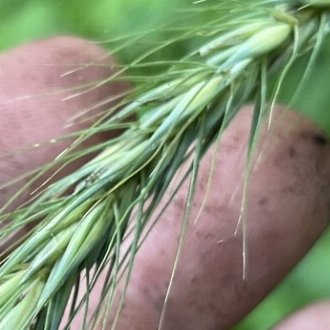Riverbank Wildrye vs Silky Wild Rye
These two species are visually similar, and can occur together in the same habitat, but they can be easily distinguished by the presence or absence of pubescence as well as differences in their spikes and foliage color. Elymus riparius is more limited to moist, usually riparian habitats, and ranges farther northeast, whereas Elymus villosus can be found in drier habitats as well, and ranges farther west and slightly farther south on the east coast. These species are not known to hybridize.
Riverbank Wildrye (Elymus riparius) | Silky Wild Rye (Elymus villosus) |
A perennial, cool-season bunchgrass native mostly to northeastern North America, typically found in riparian areas. | A perennial, cool-season bunchgrass native to eastern to central North America. |
Foliage is often somewhat glaucous (pale bluish); upper leaf surfaces either lack pubescence entirely, or are rough to the touch. Sheaths beneath leaf blade are either smooth or slightly rough, but lack dense pubescence. Photo © Zihao Wang, CC BY 4.0. | Foliage is deep green and plants also often have more parts with a yellowish hue. Upper surface of leaves is usually densely and finely pubescent, feeling silky-smooth to the touch. Sheaths beneath leaf blade, enclosing the stem, are usually also pubescent. Photo © aarongunnar, CC BY 4.0. |
Seed spike has less conspicuous pubescence, and is often glaucous. Photo © Bonnie Isaac, Public Domain. | Seed spike also has significant pubescence, usually visible in crisp photographs, and is not glaucous. Photo © Daniel J. Layton, CC BY 4.0. |
Spikes average larger (7-25 cm long, 2-4 cm wide) and look more robust. Photo © Henry Frye, Public Domain. | Spikes average smaller (4-12 cm long, 1.5-3.5 cm wide) and look more delicate. Photo © Evan Barker, Public Domain. |
Seeds are retained much longer, sometimes staying on the spike well through winter into the next year. Photo from May of the year after flowering. Photo © mjpapay, CC BY 4.0. | Seeds are shed earlier, sometimes even when the spike is still green. Photo from October shortly after seeds matured. Photo © aarongunnar, CC BY 4.0. |
Awn arrangement slightly more irregular, making different angles and crossing each other, some awns twisted. Photo © Quinten Wiegersma, CC BY 4.0. | Awns highly regular, most awns parallel or nearly so. Most awns completely straight. Photo © Ethan Rose, CC BY 4.0. |
References & External Resources
These short lists show only links helpful for ID. For a complete list of references and resources also covering other aspects of ecology, visit the links section of the full article on each plant, which is the first entry here.












